Rear SLA (1pc LCA) |

|

|

|

|
|
Rear SLA (1pc LCA) |

|

|

|

|
A “Short-Long Arm” or SLA suspension is included in the Vehicle Library as both a front and rear suspension. This configuration is also known as a “Double Wishbone” suspension. The coil spring and the shock absorber typically connect to the lower control arm. The SLA name is derived from the length of the control arms. The lower arm is typically long to provide a good spring lever ratio. The upper arm is typically short to provide the proper camber curve. This suspension is widely used on cars, light trucks, and on independent suspension heavy trucks.
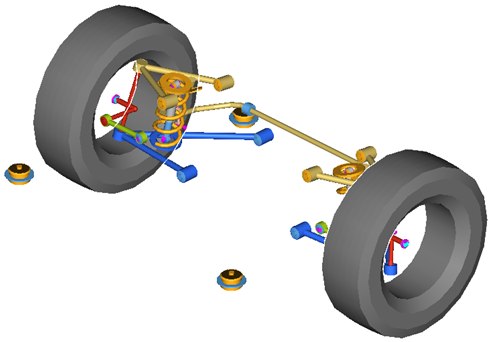
Rear SLA Suspension with One (1) Piece Lower Control Arm and Optional Subsystems: External Jounce/Rebound Bumper and Stabilizer Bar Subsystems
In conventional designs the coil spring carries the load of the spring and defines the motion of the lower ball joint location on the knuckle. The upper control arm defines the motion of the upper ball joint location on the knuckle.
| • | The wheel is connected to the wheel hub with a fixed joint. |
| • | The wheel hub is connected to the knuckle with a revolute joint. |
| • | The knuckle is connected to the upper control arm (UCA) and lower control arm (LCA) with a spherical joint. |
| • | The upper control arm and lower control arm is connected to a sub frame or the chassis with two bushings. |
| • | The lower control arm is modeled as a single rigid body (1pc LCA). |
| • | The suspension in the library is symmetric. |
The SLA suspension offers a standard set of attachments, options, and properties that you can set by selecting the suspension system in the Project Browser to display the System/Assembly panel.
Attachments determine what bodies residing outside the suspension system that the suspension attaches to. The SLA suspension with one (1) piece lower control arm includes attachments for the lower control arm (LCA), upper control arm (UCA), and toe link:
| • | The lower control arm attaches to the sub-frame by default (if a sub-frame is present). When a sub-frame is not present in the model, the Assembly Wizard attaches the lower control arm to the vehicle body. If the vehicle body is not present, for example in a half vehicle model, then the Assembly Wizard will attach the lower control arm (LCA) to ground. You can set the attachment for the lower control arm using the Attachment Wizard or by selecting the Rear SLA (1pc LCA) suspension system in the Project Browser and revising the attachments within the Attachments tab on the System/Assembly panel. |
| • | The upper control arm (UCA) to the sub-frame by default (if a sub-frame is present). When a sub-frame is not present in the model, the Assembly Wizard attaches the UCA to the vehicle body. If the vehicle body is not present, for example in a half vehicle model, then the Assembly Wizard will attach the upper control arm (UCA) to ground. You can set the attachment for the upper control arm using the Attachment Wizard or by selecting the Rear SLA (1pc LCA) suspension system in the Project Browser and revising the attachments within the Attachments tab on the System/Assembly panel. |
| • | The toe link is only found when the SLA suspension is on the rear and by default attaches to the rear sub-frame. When a rear sub-frame is not present, then the toe link attaches to the vehicle body. When a vehicle body is not present, for example in a half vehicle model, the Assembly Wizard attaches the toe link to ground. The toe link attachment can be set to any body using the Attachment Wizard or by selecting the Rear SLA (1pc LCA) suspension in the Project Browser and revising the attachments within the Attachments tab on the System/Assembly panel. |
The Rear SLA (1pc LCA) suspension system includes a Compliant option. When the SLA suspension’s Compliant option is set to No, the suspension bushings are replaced with revolute joints making the suspension kinematic. To set the value of the Compliant option, select the Rear SLA (1pc LCA) suspension in the Project Browser and click the Options tab on the System/Assembly panel.
When the Compliant option is set to No, both of the upper control arm bushings are replaced with a single revolute joint located at the front bushing of each arm, with a rotational axis directed along the line from the front bushing to the rear bushing for each of the control arms. The toe inner bushing is replaced with a universal joint, and the toe link outer bushing is replaced with a spherical joint.
The Rear SLA (1pc LCA) suspension system includes a Spindle compliance option. When the Spindle compliance option is set to Yes, the wheel body connects to the wheel hub via the universal joint and bushing. The universal joint allows camber and toe deflection of the wheel relative to the wheel hub. The wheel hub bushing’s Kx and Ky rates determine the amount of spindle compliance introduced. To set the Spindle compliance option, select the Rear SLA (1pc LCA) suspension in the Project Browser and click the Options tab on the System/Assembly panel.
The Rear SLA (1pc LCA) suspension system includes a static alignment dataset and form holding toe and camber variables that determine the orientation of the wheel relative to the knuckle and body in the Global coordinate system. The toe and camber variable values control the location of the spindle align point relative to the wheel center point through parametric expressions. You can view these expressions by selecting the spindle align point and examining its X, Y, and Z locations.
To set the values for toe and camber, select either the static alignment dataset or form and alter the values of the toe and camber variables. It is important to note that the left and right wheels’ toe and camber values must be symmetric. You cannot set the toe and camber angles independently for the two wheels.
A wide variety of model topologies can be quickly built using the Assembly Wizard. The table below shows the optional subsystems available with the SLA suspension:
Subsystem |
Options |
Stabilizer Bar |
---- |
Stabilizer Bar with Links |
Two (2) Piece Bar with Links |
Spring |
None |
Coil Spring |
None |
Shock Absorber |
None |
With Inline Joints |
With Cylindrical Joint |
Jounce Bumper |
None |
Internal to Shock |
External Jounce Bumper |
Rebound Bumper |
None |
Internal to Shock |
External Rebound Bumper |
The Vehicle Library has a large number of default connections and logic built into the library. These connections can be easily changed using the MotionView graphical user interface. It is recommended that you verify that the model has the proper topology and connections before using the results. Many of the available options are listed below:
| • | The spring connects to the lower control arm (LCA) and the vehicle body. |
| • | The LCA bushings connect to the vehicle body, unless an optional subframe is selected. When the subframe is included, the LCA bushings connect to the subframe. |
| • | Internal jounce and rebound bumpers act between the shock absorber piston and vehicle body. |
| • | External jounce and rebound bumpers act between the lower control arm and the vehicle body. |
| • | Suspensions created without a spring or a shock absorber subsystem will not function in a full vehicle analysis. |
| • | You can alter how optional subsystems attach to the suspension by selecting the subsystem in the Project Browser and altering the subsystem’s attachments. |
Points locate the joints and bushings that connect the suspension bodies to one another. The image below shows the principal points for the SLA suspension with a one piece lower control arm:
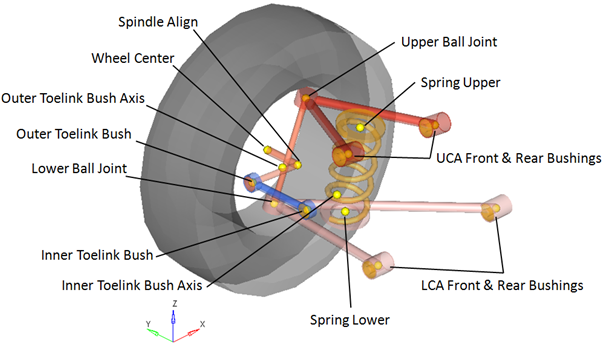
Right Side Principal Points – Rear SLA Suspension with One (1) Piece Lower Control Arm
| Note | The image above omits the left side of the suspension, points locating body centers of mass, and points that locate the optional subsystems (springs, dampers, bump stops and stabilizer bar) for clarity. |
The Rear SLA suspension with one (1) piece lower control arm is comprised of the bodies shown in the image below.
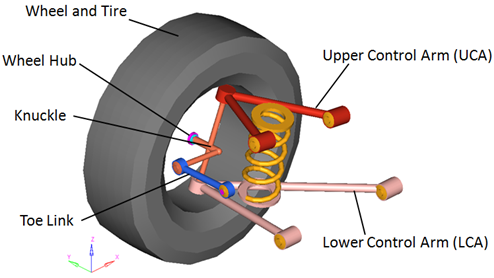
Right Side Bodies – Rear SLA Suspension with One (1) Piece Lower Control Arm
| Note | The wheel hub body has no associated graphics and therefore is not visible in the image above. |
Only right side bodies are shown (as the left side bodies are symmetrical), and the coil spring has been omitted from the image above for clarity.
The table below describes the bodies, bushings, and joints for a Rear SLA suspension with a one (1) piece lower control arm (LCA):
| Note | The shock absorber joints are documented in the shock absorber section. |
Label |
Type |
Body 1 |
Body 2 |
Point |
Notes |
Lower Ball Joint |
Spherical |
Knuckle |
Lower Control Arm |
Lower Ball Joint |
---- |
Upper Ball Joint |
Spherical |
Knuckle |
Upper Control Arm |
Upper Ball Joint |
---- |
Wheel Spindle |
Revolute |
Wheel Hub |
Knuckle |
Wheel Center |
---- |
Wheel Hub |
Fixed-Joint |
Wheel |
Wheel Hub |
Wheel Center |
When the Spindle compliance option is set to Yes, the joint type changes to universal |
LCA Front Bush |
Bushing |
Lower Control Arm |
Subframe, Vehicle Body, or Ground |
LCA Front Bush |
When the Compliant option is set to No, the bushing becomes a revolute joint. |
LCA Rear Bush |
Bushing |
Lower Control Arm |
Subframe, Vehicle Body, or Ground |
LCA Rear Bush |
When the Compliant option is set to No, this bushing is deactivated |
UCA Front Bush |
Bushing |
Upper Control Arm |
Subframe, Vehicle Body, or Ground |
UCA Front Bush |
When the Compliant option is set to No, the bushing becomes a revolute joint. |
UCA Rear Bush |
Bushing |
Upper Control Arm |
Subframe, Vehicle Body, or Ground |
UCA Rear Bush |
When the Compliant option is set to No, this bushing is deactivated |
Inner Toe Link Bush |
Universal Joint |
Toe Link |
Subframe, Vehicle Body, or Ground |
Inner Toe Link Bush |
When the Compliant option is set to Yes, this joint becomes compliant. |
Outer Toe Link Bush |
Spherical Joint |
Toe Link |
Knuckle |
Outer Toe Link Bush |
When the Compliant option is set to Yes, this joint becomes compliant. |
The following image shows the location of the joints and bushings in the suspension:
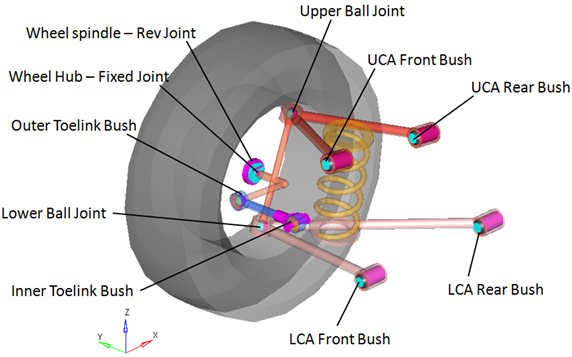
Right Side Joints and Bushings: Rear SLA Suspension with One (1) Piece Lower Control Arm
The SLA suspension system can be used in either a half car or a full vehicle analysis. The default geometry and mass is that of a passenger car or light truck, however the model and data can be revised to reflect any size vehicle, from a large truck to a scale model car.
| • | The wheel body represents the mass of the tire and the rim. |
| • | The wheel hub body represents the mass of the wheel hub and any other components that rotate with the hub, such as a brake rotor. There are no graphic entities for the wheel hub. |
| • | The upper control arm bushings are defined so their axes are parallel. If the front bushing is moved, both the front and rear bushing realign so that they have the same axis of rotation. The lower control arm bushings’ rotational axes are defined in the same manner. |
| • | Each body’s Center of Gravity (CG) is estimated from the body’s geometry. The formulas are coded into the Point panel and can be viewed using the graphical user interface. If exact CG locations are available, they should be entered as X, Y, Z coordinates instead of the estimated number. |
| • | The wheel and wheel hub parts use the Wheel CG location as the center of gravity. |
| • | When the suspension is built as a kinematic suspension, the upper control arm bushings are replaced with a single revolute joint located at the forward bushing location. The lower control arm bushings are replaced with a revolute joint in the same fashion. |
| • | A wide variety of combinations of suspensions and subsystems can be built using the Assembly Wizard. You are encouraged to build systems and understand the resulting model using the graphical user interface. |
| • | When building a new suspension model, be sure to build the model with all of the optional systems (stabilizer bar, etc.) included in the model. Immediately turn off the systems using the Project Browser and run an analysis on the base suspension to ensure it solves properly. As data becomes available for the optional systems; activate those systems and populate them with data. |
The image below shows the MotionView Project Browser view of the systems in a fully populated front suspension model. The Rear SLA susp (1 pc LCA) system has five “child” systems.
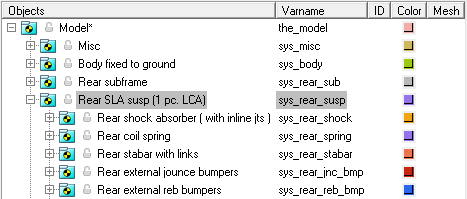
Browser view of a Rear-Half-Vehicle Model Systems and Subsystems Employing a SLA Suspension with One (1) Piece Lower Control Arm
The jounce bumper curve data and the rebound bumper curve data files are stored in the Vehicle Library and are referred to by this model. A new file should be created and substituted for these files when actual data is available.
| • | Front SLA (2pc LCA) |
| • | Rear SLA (1pc LCA) |
| • | Rear SLA (2pc LCA) |